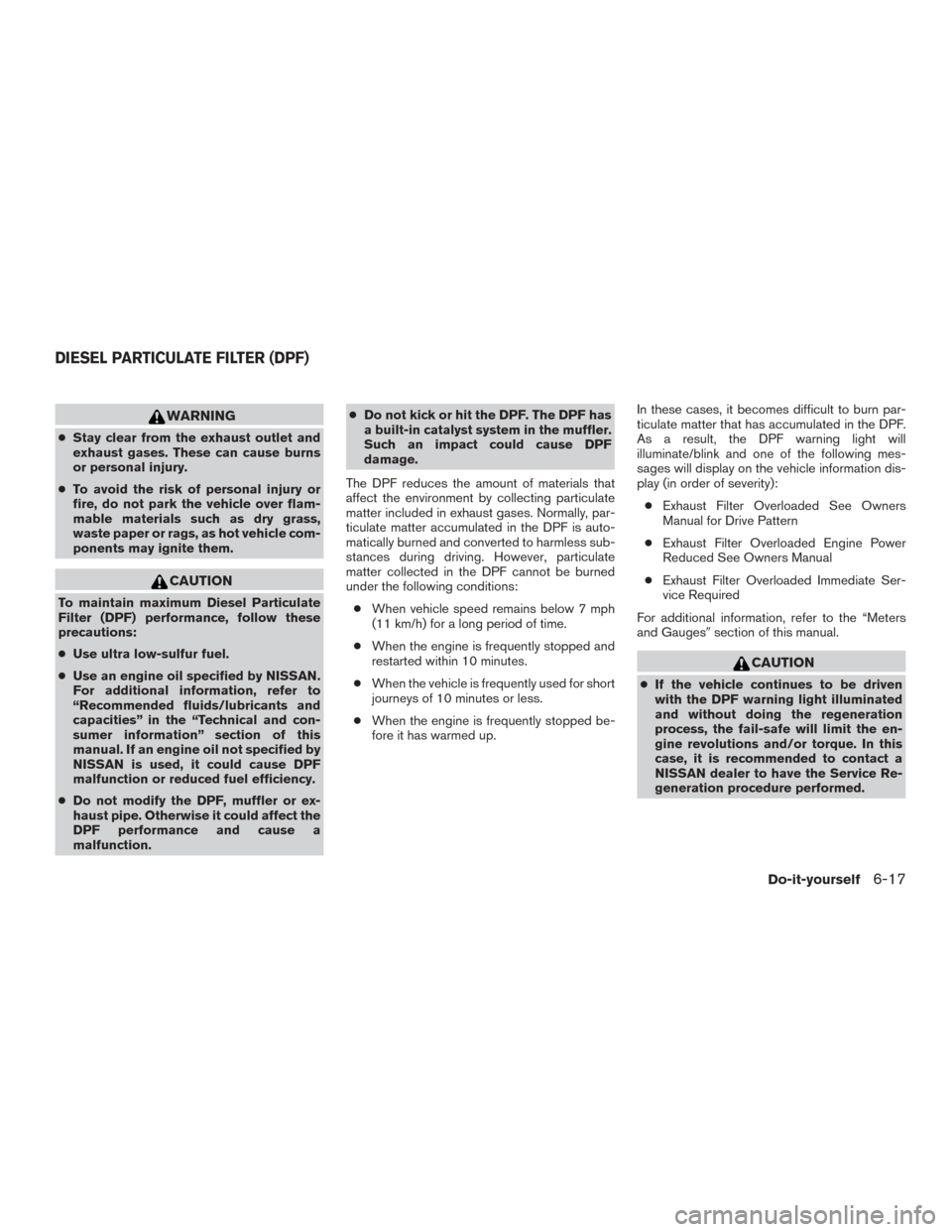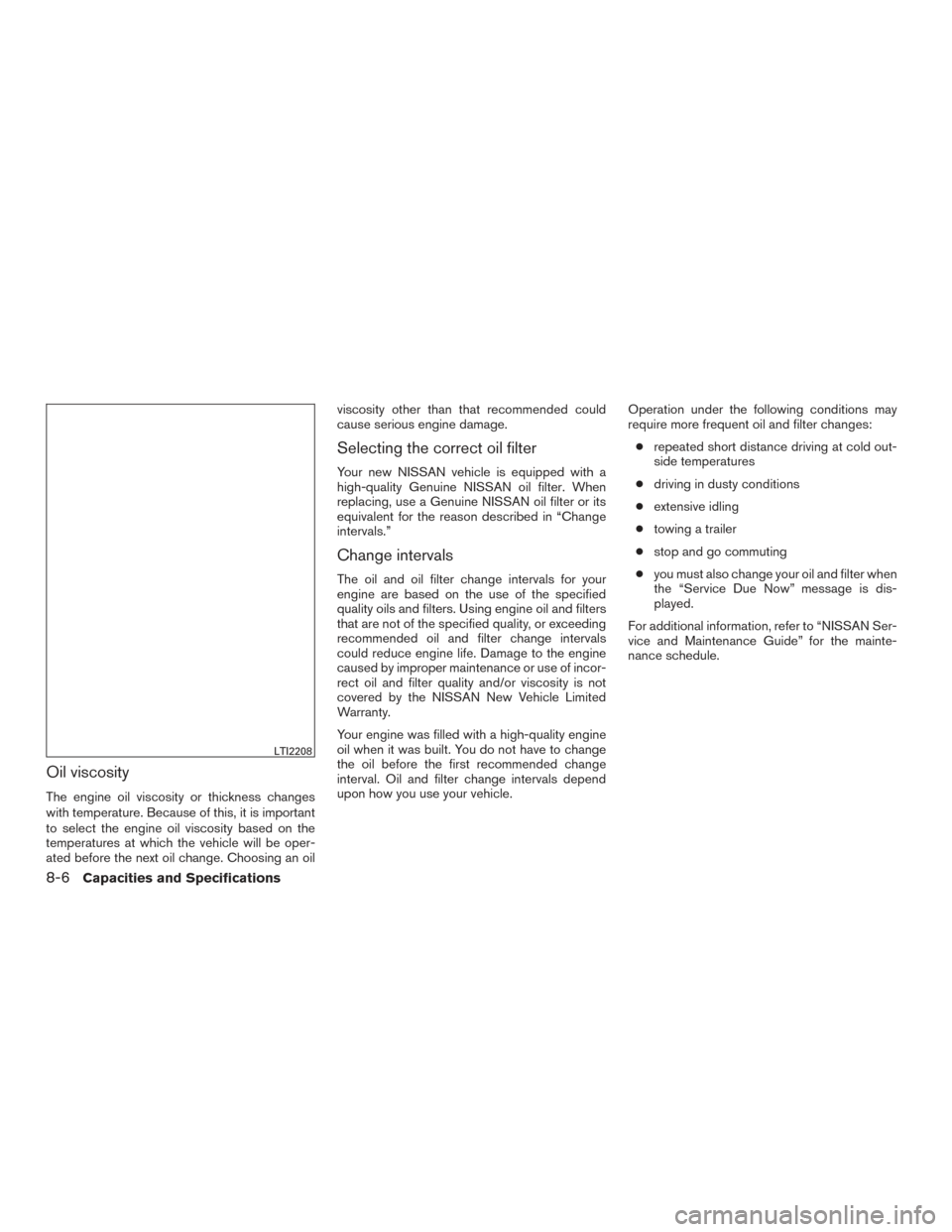Page 617 of 636

DRAINING WATER
WARNING
To avoid the risk of personal injury or fire,
drain diesel fuel into an approved con-
tainer and safely dispose of in accordance
with local environmental regulations.
CAUTION
Continuing vehicle operation without
properly draining could cause serious
damage to the engine.1. Shut the engine off. 2. Place a large drain pan under the drain valve
�A.
3. Turn the drain valve counterclockwise1/4
turn to open.
4. Drain the filter sump until clear fuel is visible. If draining the stage 1 fuel filter housing,
drain until fuel reduces to a trickle.
5. Turn the drain valve clockwise1/4 turn to
close.
FUEL SYSTEM PRIMING
WARNING
The fuel pump, high-pressure fuel lines,
and fuel rail contain very high-pressure
fuel. To reduce the possibility of personal
injury, never loosen any fittings while the
engine is running.
NOTE: ● It is not necessary to vent air from the
high-pressure fuel system before start-
ing the engine.
● Upon ignition on the electric lift pump
will run until the fuel system is primed
or 90 seconds, whichever comes first. Purge the air out of the fuel system after refilling a
completely empty fuel tank by the following pro-
cedure:
1. Turn the key ON for 90 seconds to prime the fuel system. After 90 seconds, crank the
engine for a maximum of 30 seconds or until
the engine starts. If the engine does not
start, repeat this step.
2. When the engine does start, it may operate erratically and with increased noise levels for
a few minutes. This is a normal condition as
air is being removed from the system.
NOTE:
It is possible for a warning or indicator light
to illuminate due to air entering the fuel
system. If this happens, it is recommended
you visit a NISSAN dealer for service.
LDI2898
6-16Do-it-yourself
Page 618 of 636

WARNING
●Stay clear from the exhaust outlet and
exhaust gases. These can cause burns
or personal injury.
● To avoid the risk of personal injury or
fire, do not park the vehicle over flam-
mable materials such as dry grass,
waste paper or rags, as hot vehicle com-
ponents may ignite them.
CAUTION
To maintain maximum Diesel Particulate
Filter (DPF) performance, follow these
precautions:
● Use ultra low-sulfur fuel.
● Use an engine oil specified by NISSAN.
For additional information, refer to
“Recommended fluids/lubricants and
capacities” in the “Technical and con-
sumer information” section of this
manual. If an engine oil not specified by
NISSAN is used, it could cause DPF
malfunction or reduced fuel efficiency.
● Do not modify the DPF, muffler or ex-
haust pipe. Otherwise it could affect the
DPF performance and cause a
malfunction. ●
Do not kick or hit the DPF. The DPF has
a built-in catalyst system in the muffler.
Such an impact could cause DPF
damage.
The DPF reduces the amount of materials that
affect the environment by collecting particulate
matter included in exhaust gases. Normally, par-
ticulate matter accumulated in the DPF is auto-
matically burned and converted to harmless sub-
stances during driving. However, particulate
matter collected in the DPF cannot be burned
under the following conditions: ● When vehicle speed remains below 7 mph
(11 km/h) for a long period of time.
● When the engine is frequently stopped and
restarted within 10 minutes.
● When the vehicle is frequently used for short
journeys of 10 minutes or less.
● When the engine is frequently stopped be-
fore it has warmed up. In these cases, it becomes difficult to burn par-
ticulate matter that has accumulated in the DPF.
As a result, the DPF warning light will
illuminate/blink and one of the following mes-
sages will display on the vehicle information dis-
play (in order of severity):
● Exhaust Filter Overloaded See Owners
Manual for Drive Pattern
● Exhaust Filter Overloaded Engine Power
Reduced See Owners Manual
● Exhaust Filter Overloaded Immediate Ser-
vice Required
For additional information, refer to the “Meters
and Gauges� section of this manual.
CAUTION
●If the vehicle continues to be driven
with the DPF warning light illuminated
and without doing the regeneration
process, the fail-safe will limit the en-
gine revolutions and/or torque. In this
case, it is recommended to contact a
NISSAN dealer to have the Service Re-
generation procedure performed.
DIESEL PARTICULATE FILTER (DPF)
Do-it-yourself6-17
Page 619 of 636

AUTOMATIC REGENERATION
Automatic regeneration occurs when the control
module detects the exhaust filter needs to be
cleaned. This is a normal process and will not
typically require any operator interaction.
If the automatic regeneration is not able to clean
the exhaust filter the vehicle information display
will display the following messages in order of
severity:● Exhaust Filter Overloaded See Owners
Manual for Drive Pattern
● Exhaust Filter Overloaded Engine Power
Reduced See Owners Manual for
● Exhaust Filter Overloaded Immediate Ser-
vice Required
The instructions for these messages in the “Me-
ters and Gauges” section of this manual will
inform the driver to modify their driving pattern to
enable the automatic regeneration process.
1. Idler pulley
2. Cooling fan pulley
3. Idler pulley
4. Power steering fluid pump pulley
5. Air conditioner compressor pulley
6. Water pump pulley
7. Crankshaft pulley
8. Automatic belt tensioner pulley
9. Generator pulley
WARNING
To avoid the risk of personal injury, be
sure the ignition switch is in the OFF or
LOCK position before servicing drive belt.
The engine could rotate unexpectedly.
1. Visually inspect the belt for signs of unusual wear, cuts, fraying or looseness. If the belt is
in poor condition or is loose, have it re-
placed. It is recommended you visit a
NISSAN dealer for this service.
2. Have the belt checked regularly for condi- tion and tension in accordance with the
maintenance schedule found in the “Titan
Owner’s Manual”.
LDI2881
DRIVE BELT
6-18Do-it-yourself
Page 631 of 636

Oil viscosity
The engine oil viscosity or thickness changes
with temperature. Because of this, it is important
to select the engine oil viscosity based on the
temperatures at which the vehicle will be oper-
ated before the next oil change. Choosing an oilviscosity other than that recommended could
cause serious engine damage.
Selecting the correct oil filter
Your new NISSAN vehicle is equipped with a
high-quality Genuine NISSAN oil filter. When
replacing, use a Genuine NISSAN oil filter or its
equivalent for the reason described in “Change
intervals.”
Change intervals
The oil and oil filter change intervals for your
engine are based on the use of the specified
quality oils and filters. Using engine oil and filters
that are not of the specified quality, or exceeding
recommended oil and filter change intervals
could reduce engine life. Damage to the engine
caused by improper maintenance or use of incor-
rect oil and filter quality and/or viscosity is not
covered by the NISSAN New Vehicle Limited
Warranty.
Your engine was filled with a high-quality engine
oil when it was built. You do not have to change
the oil before the first recommended change
interval. Oil and filter change intervals depend
upon how you use your vehicle.
Operation under the following conditions may
require more frequent oil and filter changes:
● repeated short distance driving at cold out-
side temperatures
● driving in dusty conditions
● extensive idling
● towing a trailer
● stop and go commuting
● you must also change your oil and filter when
the “Service Due Now” message is dis-
played.
For additional information, refer to “NISSAN Ser-
vice and Maintenance Guide” for the mainte-
nance schedule.
LTI2208
8-6Capacities and Specifications